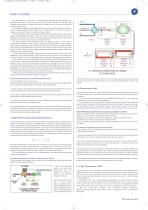
Catalog excerpts

Sulphur Analysis Evaluation of Sulphur Measurement Analytical Techniques for Sulphur in Gases and Fuel Surinder (Sandy) Thind Applications Chemist C.I.Analytics, Chambly, QB, Canada Tel: (1) 450 658 4965 Fax: (1) 450 658 3428 e-mail: sandythind@cianalytics.ca www.cianalytics.com Over the last decade, the importance of detecting sulphur in petroleum-related products has increased dramatically. This is likely related to the necessity of complying with increasingly stringent government regulations, protecting expensive catalysts, and ensuring product quality. Reasons for detection and control of sulphur in different process streams have existed for the last fifteen years, but detection limits have been reduced dramatically in recent times. For example, in order to protect expensive, sulphur-intolerant catalysts, the production feed for polypropylene or polyethylene must be monitored for sulphur content. The sulphur analyser used in this application must now have the ability to detect sulphur from 1 parts per billion to 10 parts per million. C.I. Analytics provides the best solution for each client’s sulfur analysis requirements. We are able to do so since, we offer any of the three best-known technologies in the field: Sulphur Levels in Gasoline by 2002 Sulphur Levels in Gasoline by 2005 Sulphur Levels in Diesel by 2006 < 200 ppm (At present the levels range from 300-600 ppm) This paper describes and evaluates all the latest techniques available to perform these analyses with high levels of accuracy and speed. The most Popular Technologies available to meet Ever-Tightening Regulations and low level detection for catalyst protection: Sulphur measurement may prove to be difficult, particularly at low levels, but choosing the best technological fit for the application often minimises such difficulty. This article examines the strengths and weaknesses inherent with each sulphur measurement technology currently available for detection of low levels of sulphur in hydrocarbon fuel samples and analysers used for blending operations. Best known and used Technologies offered world-wide for low-level detection of sulphur in inert gases, hydrocarbon gases, and hydrocarbon liquids include the following: 1. 2. 3. 4. 5. GC-Flame Photometric Detector (FPD and PFPD) Dry Colorimetric Method (Tape-based) Sulphur Chemiluminescence Method (SCD) UV Fluorescence (UVF) X-Ray Fluorescence (XRF) 1. Flame Photometric Detector (FPD) and Pulsed FPD: These sulphur analysers, with gas chromatograph and Flame Photometric Detector, are based on technology that has not changed over the last 40 years. The FPD, with its high selectivity for sulphur compounds, was generally the detector of choice for on-line applications in the sixties and seventies. Unfortunately, however, it suffers from a squared response, which limits its ability. The FPD is also subject to quenching of the signal by hydrocarbons and carbon dioxide. This limitation requires that the sulphur compounds be separated from the interfering matrix before detection by FPD. To reduce the hydrocarbon quenching, and to get a linear response from this detector, the following technique has been used. Using a high temperature pyrolyzer, a small amount of hydrocarbon sample is burned in air to form SO2, CO2, and H2O. These three gases are then separated on a packed column. The SO2 peak is sent to the FPD for detection while the CO2 and H20 peaks are sent to vent. At times the GC separation of H20 and SO2 is a problem. The pulsed FPD was designed to improve upon the ‘old’ traditional FPD design but has failed to perform well especially for on-line analysers. Even in the lab the PFPD offers many challenges and requires special training. 2. Tape Based Detectors: Dry Colorimetric Detector (DCD) Dry Colorimetric Detector Technique to detect sulphur in petroleum samples is still the most wildly used and reliable technique. Theory of Operation Classical colorimetry utilises an impinger to collect gas in a liquid medium. Chemical reagents are then added to the medium to cause it to change colour in proportion to the concentration of gas present. The resulting colour change is measured by a laboratory spectrophometer and compared to standards. Sensi-Tape Detectors are also colorimetric based, but are dry reaction substrates which serve as gas collecting and analysing media. Individually formulated for a specific gas or family of gases, each SensiTape is a nontoxic, proprietary chemical reagent system. When exposed to a target gas, the tape will change colour in proportion to the amount of gas: the higher the concentration, the darker the stain will appear. The change in colour, or stain, on the Sensi-Tape is read by a photo-optical system, then compared to a standard response curve preprogrammed into the system. Chemical formulations deposited on the tape provide a detection medium that is fast, sensitive, and specific. Each of the proprietary detector tapes reacts instantly to the target gas, providing a visible colour reaction. As a result, tape detectors provide a method of detecting and analysing toxic gases that must be identified in process streams at PPB levels and removed. While the Tape Detection System is extremely sensitive to its target gas, it is also very specific to that gas. It will not react to other substances (solvents, hydrocarbons, etc.) often found in process streams. Thus, expensive downtime due to false alarms is virtually eliminated.
Open the catalog to page 1
Sulphur Analysis The Tape detector is the most ‘loved’ or ‘hated’ technique depending upon the application. The organically bound sulphur is first converted to H2S. The H2S formed reacts with the moist paper tape impregnated with chemicals. An electronic eye detects the change in colour of the tape as H2S passes by the tape and forms a stain. The tape detection method is the only detection system that can determine H2S without any interference. This fact is clearly stipulated in ASTM method. This is an important feature in a detector when one is detecting very low levels of sulphur in a...
Open the catalog to page 2




